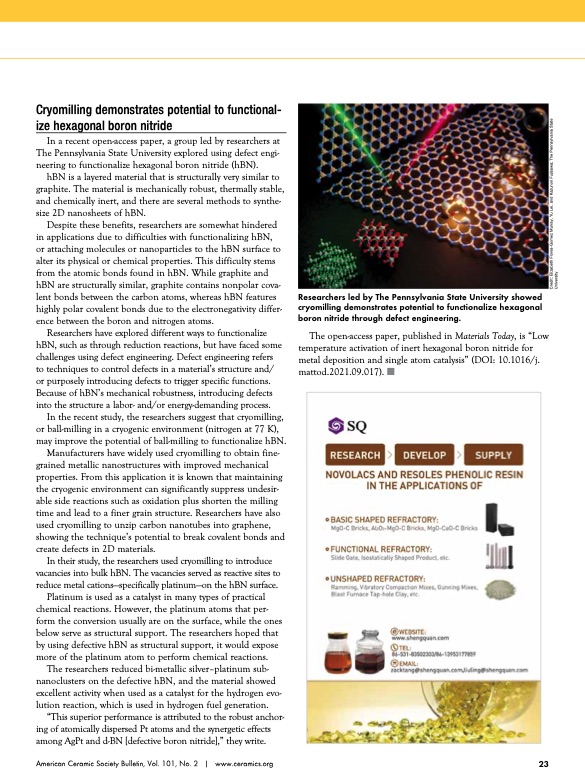
PDF Publication Title:
Text from PDF Page: 025
Cryomilling demonstrates potential to functional- ize hexagonal boron nitride In a recent open-access paper, a group led by researchers at The Pennsylvania State University explored using defect engi- neering to functionalize hexagonal boron nitride (hBN). hBN is a layered material that is structurally very similar to graphite. The material is mechanically robust, thermally stable, and chemically inert, and there are several methods to synthe- size 2D nanosheets of hBN. Despite these benefits, researchers are somewhat hindered in applications due to difficulties with functionalizing hBN, or attaching molecules or nanoparticles to the hBN surface to alter its physical or chemical properties. This difficulty stems from the atomic bonds found in hBN. While graphite and hBN are structurally similar, graphite contains nonpolar cova- lent bonds between the carbon atoms, whereas hBN features highly polar covalent bonds due to the electronegativity differ- ence between the boron and nitrogen atoms. Researchers have explored different ways to functionalize hBN, such as through reduction reactions, but have faced some challenges using defect engineering. Defect engineering refers to techniques to control defects in a material’s structure and/ or purposely introducing defects to trigger specific functions. Because of hBN’s mechanical robustness, introducing defects into the structure a labor- and/or energy-demanding process. In the recent study, the researchers suggest that cryomilling, or ball-milling in a cryogenic environment (nitrogen at 77 K), may improve the potential of ball-milling to functionalize hBN. Manufacturers have widely used cryomilling to obtain fine- grained metallic nanostructures with improved mechanical properties. From this application it is known that maintaining the cryogenic environment can significantly suppress undesir- able side reactions such as oxidation plus shorten the milling time and lead to a finer grain structure. Researchers have also used cryomilling to unzip carbon nanotubes into graphene, showing the technique’s potential to break covalent bonds and create defects in 2D materials. In their study, the researchers used cryomilling to introduce vacancies into bulk hBN. The vacancies served as reactive sites to reduce metal cations—specifically platinum—on the hBN surface. Platinum is used as a catalyst in many types of practical chemical reactions. However, the platinum atoms that per- form the conversion usually are on the surface, while the ones below serve as structural support. The researchers hoped that by using defective hBN as structural support, it would expose more of the platinum atom to perform chemical reactions. The researchers reduced bi-metallic silver–platinum sub- nanoclusters on the defective hBN, and the material showed excellent activity when used as a catalyst for the hydrogen evo- lution reaction, which is used in hydrogen fuel generation. “This superior performance is attributed to the robust anchor- ing of atomically dispersed Pt atoms and the synergetic effects among AgPt and d-BN [defective boron nitride],” they write. Researchers led by The Pennsylvania State University showed cryomilling demonstrates potential to functionalize hexagonal boron nitride through defect engineering. The open-access paper, published in Materials Today, is “Low temperature activation of inert hexagonal boron nitride for metal deposition and single atom catalysis” (DOI: 10.1016/j. mattod.2021.09.017). n American Ceramic Society Bulletin, Vol. 101, No. 2 | www.ceramics.org 23 Credit: Elizabeth Flores-Gomez Murray, Yu Lei, and Kazunori Fujisawa; The Pennsylvania State UniversityPDF Image | hydrogen as an alternative fuel

PDF Search Title:
hydrogen as an alternative fuelOriginal File Name Searched:
March2022.pdfDIY PDF Search: Google It | Yahoo | Bing
CO2 Organic Rankine Cycle Experimenter Platform The supercritical CO2 phase change system is both a heat pump and organic rankine cycle which can be used for those purposes and as a supercritical extractor for advanced subcritical and supercritical extraction technology. Uses include producing nanoparticles, precious metal CO2 extraction, lithium battery recycling, and other applications... More Info
Heat Pumps CO2 ORC Heat Pump System Platform More Info
| CONTACT TEL: 608-238-6001 Email: greg@infinityturbine.com | RSS | AMP |